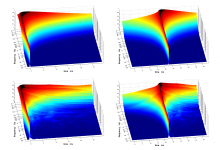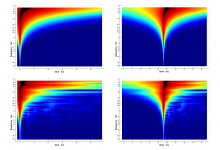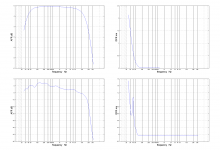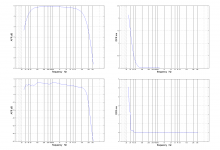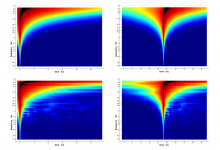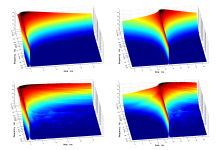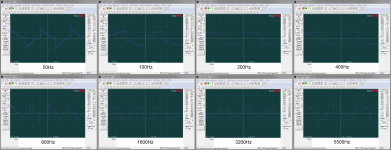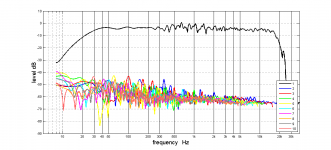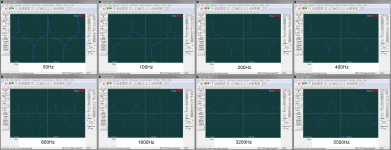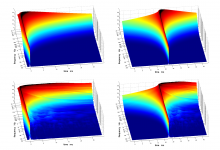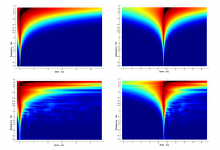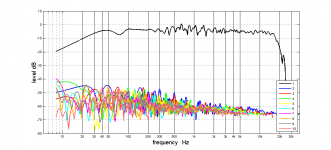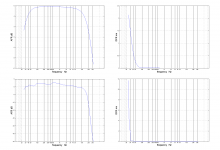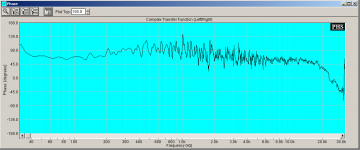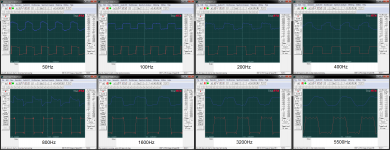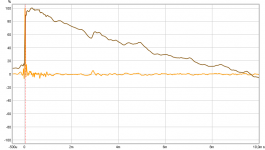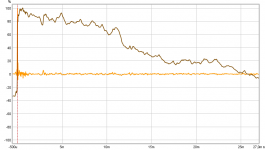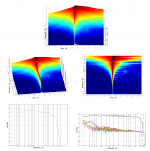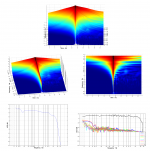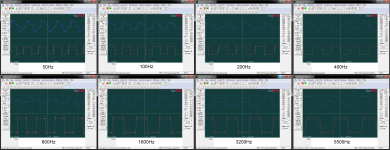Lovely software Raimonds and thanks new EQ setting, from within 1 meter sounds really great but as said i use one counter PEQ to fight boomy room sound to suit more normal listening distances.
Exercised a bit with program and see it can fine import IR from other software so made a IRR bandpass target profile in Rephase at 96kHz that looks close to my speakers actual bandpass BW2 30Hz to BW2 18,8kHz measured at 30 cm distance. Attach plots where perfect targets is at top and actual progress so far below.
Exercised a bit with program and see it can fine import IR from other software so made a IRR bandpass target profile in Rephase at 96kHz that looks close to my speakers actual bandpass BW2 30Hz to BW2 18,8kHz measured at 30 cm distance. Attach plots where perfect targets is at top and actual progress so far below.
Attachments
Last edited:
Results associated "just AFR correction BYRTT_1p_AFReq.wav" combined Rephase created FIR filter explained post 179.
Square waves and APL_TDA plots with targets at top set to BW2 30Hz -BW2 18,8kHz.
Square waves and APL_TDA plots with targets at top set to BW2 30Hz -BW2 18,8kHz.
Attachments
Last edited:
Results associated "AFR and DFR correction BYRTT_1p_A&Deq.wav".
Square waves and APL_TDA plots with targets at top set to BW2 30Hz -BW2 18,8kHz.
 this one timing looks super flat most of band but no squarer waves.
this one timing looks super flat most of band but no squarer waves.
Square waves and APL_TDA plots with targets at top set to BW2 30Hz -BW2 18,8kHz.
 this one timing looks super flat most of band but no squarer waves.
this one timing looks super flat most of band but no squarer waves.Attachments
Last edited:
BYRTT, did you try the AFR and DFR corrected version too? From post #180?
Above 😀
All components are shifted by 90 degr in result - Hilbert transform ...
But why : )))
Really don't know but reminds me minimum phase AC filter coupling function BP/HP/LP, inductors and capacitors, and 90º phase shift per order.
Enjoyed music via first 25 pulse filter all evening, quality is incredible good work.
Hi Raimonds,
Is it possible to get EQ correction IR-wav file from post 174 in 44,1 and 192kHz. Ask because done some loop tests and it looks like SRC don't come for free, in two examples below its a SPDIF I/O loopback where WDM is locked 44,1kHz and REW is run at 44,1kHz and 48Khz. Don't think JRiver DSP distort as much as WDM but can see output frq response is distorted from JRiver when plug ins is not native sample rate. If its possible to do myself would like to have a tip, had a try in Audacity but in exported file one could see that even peaks and dip scheme was same they were not in sync at same frq points.
Is it possible to get EQ correction IR-wav file from post 174 in 44,1 and 192kHz. Ask because done some loop tests and it looks like SRC don't come for free, in two examples below its a SPDIF I/O loopback where WDM is locked 44,1kHz and REW is run at 44,1kHz and 48Khz. Don't think JRiver DSP distort as much as WDM but can see output frq response is distorted from JRiver when plug ins is not native sample rate. If its possible to do myself would like to have a tip, had a try in Audacity but in exported file one could see that even peaks and dip scheme was same they were not in sync at same frq points.
Attachments
Hi BYRTT,
Interesting that resampler is whistling at 48000-44100=3900 Hz and that is displayed as 355 Hz on 11. harmonic`s curve, as 390 at 10. harmonic`s, 433 at 9. and so on.
You may use any reliable wav editor to resample to any sample rate you need.
The slight difference you observed may be caused by too short FFT block size.
The padding with zeros to block size of 65536 or even more will make curves more accurate and readable.
You should consider use of APL VST plagin. It is converting IR`s to any necessary SR by itself and automatically at any stream SR change.
Interesting that resampler is whistling at 48000-44100=3900 Hz and that is displayed as 355 Hz on 11. harmonic`s curve, as 390 at 10. harmonic`s, 433 at 9. and so on.
You may use any reliable wav editor to resample to any sample rate you need.
The slight difference you observed may be caused by too short FFT block size.
The padding with zeros to block size of 65536 or even more will make curves more accurate and readable.
You should consider use of APL VST plagin. It is converting IR`s to any necessary SR by itself and automatically at any stream SR change.
BYRTT,
You might want to check how APL VST plagin Works with FIR-filters on your audio system. If you live not far away from Copenhagen, we could arrange a meeting. I have both TDA, Workshop and APL plugin installed on my PC. It is also possible to create FIR-filters for your left/right speakers.
BR
Alex
You might want to check how APL VST plagin Works with FIR-filters on your audio system. If you live not far away from Copenhagen, we could arrange a meeting. I have both TDA, Workshop and APL plugin installed on my PC. It is also possible to create FIR-filters for your left/right speakers.
BR
Alex
You should consider use of APL VST plagin. It is converting IR`s to any necessary SR by itself and automatically at any stream SR change.
JRiver's convolution engine also converts the impulse to any SR that is played at that time, but you have a separate option to provide files for every SR.
Hi BYRTT,
Interesting that resampler is whistling at 48000-44100=3900 Hz and that is displayed as 355 Hz on 11. harmonic`s curve, as 390 at 10. harmonic`s, 433 at 9. and so on.
You may use any reliable wav editor to resample to any sample rate you need.
The slight difference you observed may be caused by too short FFT block size.
The padding with zeros to block size of 65536 or even more will make curves more accurate and readable.
You should consider use of APL VST plagin. It is converting IR`s to any necessary SR by itself and automatically at any stream SR change.
Thanks tips admit personal not sharp in stuff as FFT block size and padding with zeros to block size, so in time will look closer into subject.
My DSP is JRiver and internal it seems run 64bit engine and with wesayso's info below maybe i should not worry it can distort as Windows sound system can. Must think about a clever route to benchmark JRiver DSP engine as a quality check, the trouble is it runs via ASIO so on same computer its hard to get more programs inside loop.
APL EP1 VST plugin and APL TDA EQ looks like great and pro tools, wonder would VST plugin placed inside JRiver DSP engine support one IR-file correction for each of my soundcards eight outputs or will it only support two channels (L&R). The two tools cost would sum at €470 that number for non pro use is costly exercise.
BYRTT,
You might want to check how APL VST plagin Works with FIR-filters on your audio system. If you live not far away from Copenhagen, we could arrange a meeting. I have both TDA, Workshop and APL plugin installed on my PC. It is also possible to create FIR-filters for your left/right speakers.
BR
Alex
Thousand thanks that is very kindly offer and would serious think about it, unfortunate i live over in Jutland beside small country town Faarup positioned in middle between Randers and Hobro.
Have myself measurement package APL_TDA and what a great tool.
JRiver's convolution engine also converts the impulse to any SR that is played at that time, but you have a separate option to provide files for every SR.
Thanks sounds as i shouldn't care then, also I'm on family v20.x but have license to latest v21x, so should maybe give that a try and run a test benchmark with and without SRC in convolution container.
Not wanting to take off topic, but I have some questions about how the DSP correction you are implementing here interacts with an active system, e.g. with drivers directly driven by amps, either with an analogue crossover or digital with FIR. This query is not so much about crossover slopes, phase, and any lobing through the crossover, but more about the control of the amplifier over the cone when it sidesteps the passive crossover. Does DSP eliminate this active advantage?
Another phrasing might ask, can DSP turn a low damping factor tube amp into a Krell? (at the measured spl).
Another phrasing might ask, can DSP turn a low damping factor tube amp into a Krell? (at the measured spl).
IIR or FIR DSP basically changes the source signal before it goes to the amp(s). Either to build a crossover (only send 20-400Hz to the woofer amp) or to compensate for linear distortion (or phase distortion with FIR) later in the chain (driver nonlinearities, baffle diffraction, crossover phase rotation, or even room modes)
I don't see how that can influence the control an amp has over a speaker or for active, the driver. Impedance flattening circuits can (analogue components between amp and driver) and can be mixed with DSP. Wesayso uses one for his towers if I'm not mistaken. You can read about it somewhere in this glorious thread:
http://www.diyaudio.com/forums/full...o-towers-25-driver-full-range-line-array.html
I don't see how that can influence the control an amp has over a speaker or for active, the driver. Impedance flattening circuits can (analogue components between amp and driver) and can be mixed with DSP. Wesayso uses one for his towers if I'm not mistaken. You can read about it somewhere in this glorious thread:
http://www.diyaudio.com/forums/full...o-towers-25-driver-full-range-line-array.html
Thanks for the pointer to Wesayo´s thread, impressive! I understand your reply, but if the original measurements used to generate your filter include the amplifier (they must to drive the speaker), then won´t the filter also include the transfer function of the amplifier, and any departures it introduces from linearity? As I understand it, the DSP corrects by comparing acoustic output to the original signal file. Would it not also correct, then, any deviations introduced by the ability of the amplifier to drive either the driver directly, or through a passive filter? In the bass, can it turn a SET into a Krell, if the SET was used when measuring?
I think someone with a good undestanding of both amplifier topology and DSP filtering is needed for a complete answer here. However, I think it's an interesting question and something I have thought about myself so pardon my butting in.
The filter will potentially linearize the freq/phase response of the entire playback chain (dac/amp/speaker), and a "tightening" of the response can be achieved. However, my understanding of amplifier feedback is that it has an effect on non-linear distortion which means that some differences will remain between an SET and a high powered amp despite equalization.
For what it's worth, I like the approach of relying on DSP and the speaker itself for a clean impulse response combined with an amp that does not "grip" the speaker.
The filter will potentially linearize the freq/phase response of the entire playback chain (dac/amp/speaker), and a "tightening" of the response can be achieved. However, my understanding of amplifier feedback is that it has an effect on non-linear distortion which means that some differences will remain between an SET and a high powered amp despite equalization.
For what it's worth, I like the approach of relying on DSP and the speaker itself for a clean impulse response combined with an amp that does not "grip" the speaker.
Put some more time into tweaking with APL_TDA, news is extended low end reach with IRR filters now roll off in 15-20Hz area and made new FIR correction that suits new low end reach in two versions, one with linear phase in lows and one with phase turn as a 15Hz IRR BW2 stopband.
Attachments
help !;
please somebody help me!;
i got an error when running apl_tda;
matlab runtime had been installed;
running win xp sp3;
please somebody help me!;
i got an error when running apl_tda;
matlab runtime had been installed;
running win xp sp3;
An externally hosted image should be here but it was not working when we last tested it.
- Home
- Loudspeakers
- Full Range
- The room correction or speaker correction? What can we do with dsp power now availabl
